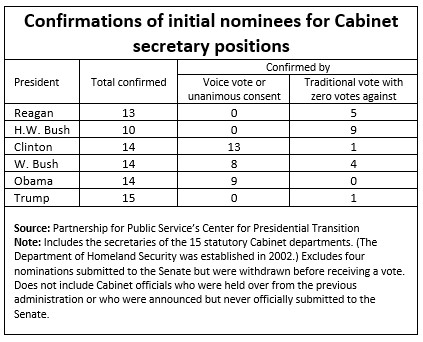Blog
January 14, 2021
Most Early Cabinet Secretary Picks Get Confirmed by the Senate With Little Opposition
For Presidents Clinton, Bush and Obama, 71% of their initial Cabinet secretaries were confirmed by voice vote or unanimous consent
By Carlos Galina and Drew Flanagan
For new presidents, having Cabinet secretaries in place as soon as they take office is crucial to ensure the continuity of the government, especially during times of crisis. The Senate has understood the need for a new president to be ready to govern, giving recent incoming chief executives significant latitude by confirming their Cabinet choices quickly and often with little or no opposition.
Under Presidents Bill Clinton, George W. Bush and Barack Obama, 71% of initial Cabinet secretaries confirmations were approved by the Senate using voice votes or unanimous consent agreements. Almost every initial Cabinet nominee during the past four decades has been approved, most facing little objection.

Voice votes and unanimous consent agreements are used by the Senate to advance legislation and confirmations quickly. Unlike most Senate votes, these procedures do not require individual senators to record their vote and are reserved for issues where there is a wide consensus and no doubt about the outcome. The extensive use of voice votes and similar agreements demonstrate how little congressional opposition recent presidents have faced regarding their first choices to head the executive departments.
The lack of Senate objections extends to the two administrations preceding Clinton as well. Even though the Senate did not use voice votes for the initial Cabinet nominations of Presidents Ronald Reagan and George H. W. Bush, votes against their picks were rare. Reagan’s choices were confirmed by an average margin of 90 votes, and five were approved unanimously. Furthermore, nine of the 10 of the Cabinet nominees confirmed under H.W. Bush were approved unanimously. The tenth, Secretary of Health and Human Services Louis Sullivan, was approved by a vote of 98-1.
President Donald Trump’s initial Cabinet nominees were more controversial than those of previous presidents and therefore faced more Senate opposition. None were confirmed by voice vote or unanimous consent. However, Trump’s experience represents the exception rather than the rule. Because Trump’s transition team leadership changed immediately following the 2016 election, Trump had a late start identifying and vetting candidates. Even with the delays, the Senate generally gave Trump the leeway to choose members of his Cabinet. All 15 Cabinet secretaries who received a Senate vote were confirmed, with nine of those receiving at least 60 votes. Trump’s initial choice for Labor Department secretary, Andy Puzder, was submitted to the Senate, but withdrew before receiving a vote.
As President-elect Joe Biden prepares to enter office, the Senate will soon consider his choices for important leadership roles. The frequent use of voice votes during the past 40 years demonstrates how the Senate can support the transition process by confirming Cabinet choices quickly. A return to this historical precedent would help ensure the Biden administration is prepared to manage the significant challenges currently facing our country.



